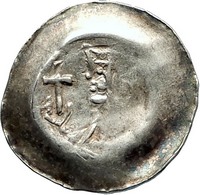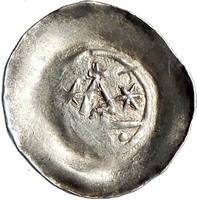France. Medieval. Cologne
Heinrich von Virneburg
Silver Denier 16mm (0.48 grams) Struck circa 12th-13th Century A.D.
Reference: Rob. 9008 var.
Bishop holding long cross.
Tower on wall between stars.
You are bidding on the exact item pictured, provided with a Certificate of Authenticity and Lifetime Guarantee of Authenticity.
Cologne is the largest city of Germany's most populous federal state of North Rhine-Westphalia, and its 1 million+ (2016) inhabitants make it the fourth most populous city in Germany after Berlin, Hamburg, and Munich. The largest city on the Rhine, it is also the most populous city both of the Rhine-Ruhr Metropolitan Region, which is Germany's largest and one of Europe's major metropolitan areas, and of the Rhineland. Centred on the left bank of the Rhine, Cologne is about 45 kilometres (28 mi) southeast of North Rhine-Westphalia's capital of Düsseldorf and 25 kilometres (16 mi) northwest of Bonn. It is the largest city in the Central Franconian and Ripuarian dialect areas. The city's famous Cologne Cathedral (Kölner Dom) is the seat of the Catholic Archbishop of Cologne. There are many institutions of higher education in the city, most notably the University of Cologne (Universität zu Köln), one of Europe's oldest and largest universities, the Technical University of Cologne (Technische Hochschule Köln), Germany's largest university of applied sciences, and the German Sport University Cologne (Deutsche Sporthochschule Köln), Germany's only sport university. Cologne Bonn Airport (Flughafen Köln/Bonn) is Germany's seventh-largest airport and lies in the southeast of the city. The main airport for the Rhine-Ruhr region is Düsseldorf Airport. Cologne was founded and established in Ubii territory in the 1st century AD as the Roman Colonia Claudia Ara Agrippinensium, the first word of which is the origin of its name. An alternative Latin name of the settlement is Augusta Ubiorum, after the Ubii. "Cologne", the French version of the city's name, has become standard in English as well. The city functioned as the capital of the Roman province of Germania Inferior and as the headquarters of the Roman military in the region until occupied by the Franks in 462. During the Middle Ages it flourished on one of the most important major trade routes between east and west in Europe. Cologne was one of the leading members of the Hanseatic League and one of the largest cities north of the Alps in medieval and Renaissance times. Prior to World War II the city had undergone several occupations by the French and also by the British (1918-1926). Cologne was one of the most heavily bombed cities in Germany during World War II, with the Royal Air Force (RAF) dropping 34,711 long tons (35,268 tonnes) of bombs on the city. The bombing reduced the population by 95%, mainly due to evacuation, and destroyed almost the entire city. With the intention of restoring as many historic buildings as possible, the successful postwar rebuilding has resulted in a very mixed and unique cityscape. Cologne is a major cultural centre for the Rhineland; it hosts more than 30 museums and hundreds of galleries. Exhibitions range from local ancient Roman archeological sites to contemporary graphics and sculpture. The Cologne Trade Fair hosts a number of trade shows such as Art Cologne, imm Cologne, Gamescom, and the Photokina. Middle AgesEarly medieval Cologne was part of Austrasia within the Frankish Empire. In 716, Charles Martel commanded an army for the first time and suffered the only defeat of his life when Chilperic II, King of Neustria, invaded Austrasia and the city fell to him in the Battle of Cologne. Charles fled to the Eifel mountains, rallied supporters, and took the city back that same year after defeating Chilperic in the Battle of Amblève. Cologne had been the seat of a bishop since the Roman period; under Charlemagne, in 795, bishop Hildebold was promoted to archbishop.[4] In 843, Cologne became a city within the Treaty of Verdun-created East Francia. In 953, the archbishops of Cologne first gained noteworthy secular power, when bishop Bruno was appointed as duke by his brother Otto I, King of Germany. In order to weaken the secular nobility, who threatened his power, Otto endowed Bruno and his successors on the bishop's see with the prerogatives of secular princes, thus establishing the Electorate of Cologne, formed by the temporal possessions of the archbishopric and included in the end a strip of territory along the left Bank of the Rhine east of Jülich, as well as the Duchy of Westphalia on the other side of the Rhine, beyond Berg and Mark. By the end of the 12th century, the Archbishop of Cologne was one of the seven electors of the Holy Roman Emperor. Besides being prince elector, he was Arch-chancellor of Italy as well, technically from 1238 and permanently from 1263 until 1803. Following the Battle of Worringen in 1288, Cologne gained its independence from the archbishops and became a Free City. Archbishop Sigfried II von Westerburg was forced into exile in Bonn. The archbishop nevertheless preserved the right of capital punishment. Thus the municipal council (though in strict political opposition towards the archbishop) depended upon him in all matters concerning criminal justice. This included torture, which sentence was only allowed to be handed down by the episcopal judge, the so-called "Greve". This legal situation lasted until the French conquest of Cologne. Besides its economic and political significance Cologne also became an important centre of medieval pilgrimage, when Cologne's Archbishop Rainald of Dassel gave the relics of the Three Wise Men to Cologne's cathedral in 1164 (after they, in fact, had been captured from Milan). Besides the three magi Cologne preserves the relics of Saint Ursula and Albertus Magnus. Cologne's location on the river Rhine placed it at the intersection of the major trade routes between east and west as well as the main Western Europe trade route, South - North Northern Italy-Flanders. These two trade routes were the basis of Cologne's growth. By 1300 the city population was 50,000-55,000. Cologne was a member of the Hanseatic League in 1475, when Frederick III confirmed the city's imperial immediacy.
|



